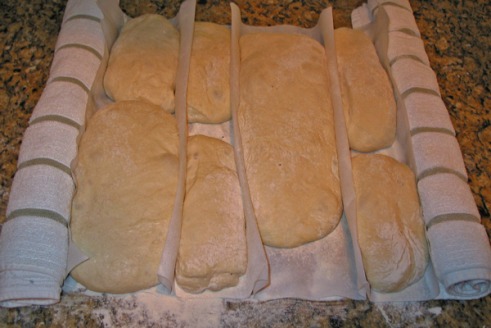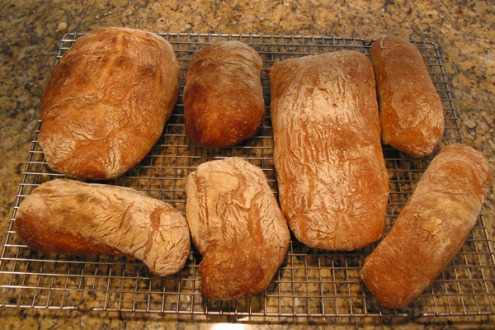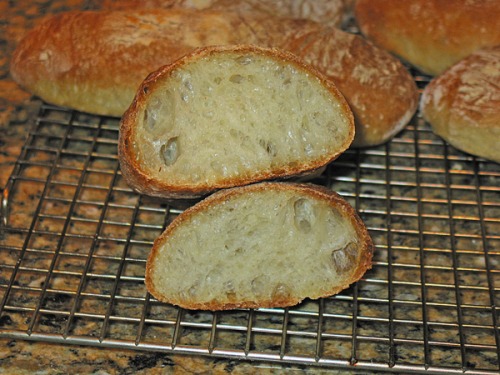I was very pleased with the Baguettes made with the poolish pre-ferment so I decided to use a poolish for my second formula. As expected the high hydration of the ciabatta dough made handling it a bit of a challenge. I have however come to enjoy working with the soft high hydration doughs. There is something about them after they have been properly developed that just feels alive.
The poolish fermented 14 hours prior to mixing the dough. There was nothing remarkable about putting the dough together, it was really straight forward. I have however come to the realization that, for better or worse, I have developed my own baking style and way of doing things. That makes it almost impossible for me to say I followed the written instructions to the letter.

Final Proofing
The way I handled the shaping of the loaves was to use Parchment paper as a couche to keep the loaves from spreading all over the place. I started by folding, misting with oil and adding a heavy dusting of flour to the parchment paper. Rolled dish towels were used as stops on either side. Not as prescribed by JH but it seemed to get the job done. The loaves were flipped just prior to baking. Baking them on parchment made getting the sticky dough off the peel a lot easier. As I found out on my Baguette adventure the formulas in the book are, to my way of thinking, a little large for the home cook. The volume stretches the capacity of my KA 4.5 and I couldn't get all the loaves on my oven stone at one time.

Two Bakings
Once again contrary to JH's instructions I pre-heated my oven to 500 degrees F for about an hour prior to baking. This gave the 3/4" thick FibraMent oven stone plenty time to stabilize at temperature. After putting in the first group of loaves and steaming with a cup of boiling water in a pan at the bottom of the oven, the oven temp was cut back to the prescribed 460 degrees F. After 10 minutes I remove the steaming pan and turned the loaves 180. At this point the bread had already acquired significant color. I reduced the oven temperature another 40 degrees to 420 and continued baking for another 12 minutes. This check found that the bread had good color and an internal temperature of 204 Degrees F. Next I tried something I had never tried before. I turned off the oven and left the door open about 6" for 5 minutes before removing the bread. My thought process was that this might give me a crisp crust that stayed crisp after cooling. I have been pleased with the results. It took a while for my oven to come back up to temperature for the second bake. By now the final proofing for the second baking had been extended by close to an hour. I couldn't detect any difference in the quality or taste of the breads between the two bakings. Because I didn't wait for the stone to soak at 500 for the second bake, my oven time was extended by about 5 minutes and I didn't have to go to 420 degrees F at all.

The Crumb
The bread has what I consider to be an appropriate crumb, a pleasingly crisp crust and wonderful flavor. I am pleased and I will continue to experiment with leaving the oven door open to finish my lean breads.
As with the Baguettes I used KA Unbleached Bread Flour and Red Star Instant yeast.
Comments/advice please. A big part of what I anticipated when joining this challenge was being able to establish dialogs with like minded ppl. I'm not looking for warm and fuzzy atta-boys but rather a give and take from with we can all learn and grow.
Mike.



 RSS Feed
RSS Feed